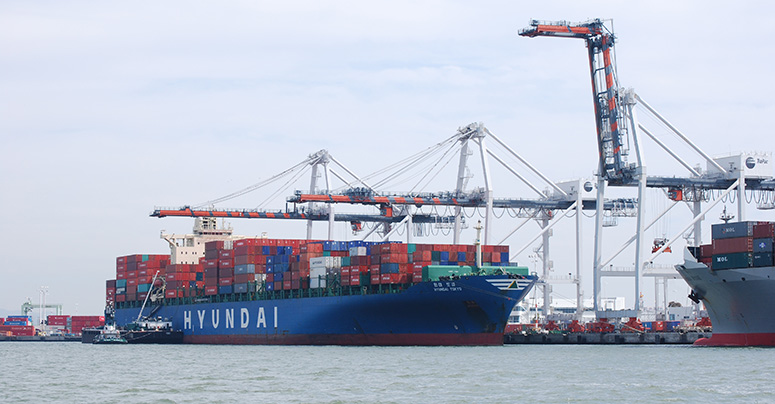If you haven't seen the Port of Oakland lately, you wouldn't recognize the place. That's the message the port delivered to customers last month in its mid-year report.

Photo by Joel Williams
By Patrick Burnson
Published: July, 2016
If you haven’t seen the Port of Oakland lately, you wouldn’t recognize the place. That’s the message the port delivered to customers last month in its mid-year report.
“It’s not your father’s Port of Oakland anymore,” said Executive Director Chris Lytle in a message sent to about 1,000 shippers, trucking companies and other port users. “Here’s the year-to-date in shorthand: consolidation, transformation, collaboration.”
The port’s six-month recap summarizes a first-quarter consolidation from five to four marine terminals. It recounts operational transformation ranging from extended service hours to an appointment system for import pick-up. The port said its changes address overcapacity in marine terminals, customer pleas for better service and rising cargo volume.
According to the report, change has been the result of collaboration with those who rely on the port. “Everyone from cargo owners to motor carriers has weighed in on how and why we should change,” said Maritime Director John Driscoll. “Our objective is to improve performance in areas that benefit them the most.”
The port highlighted these changes to operations in the first six months of 2016:
A night shift at marine terminal gates;
An appointment system for harbor trucker drivers;
A container yard devoted exclusively to empty container pick-up/return;
New express programs to expedite import container pick-ups;
Additional labor and equipment;
New berthing procedures for megaships;
Mobile phone apps to measure terminal transaction times.
Port of Stockton Plans for the New Fiscal Year
Port of Stockton officials recently released a conservative budget for the fiscal year that began this month, projecting net income of $13.5 million on revenues of $52.9 million, up slightly from what is thought to be net income of $13.2 million on $51.4 million in revenue for the fiscal year just ended.
Michelle Bowling, the port’s controller, said the agency anticipates $17.4 million in capital improvement projects for 2016-17, down from $24.3 million in capital outlays for the past fiscal year. This coming year’s projects include the widening of Navy Drive, related to the Crosstown Freeway extension, as well as a new Navy Drive bridge, port dredging operations, utility improvements and security upgrades.
Most of the port’s revenue growth will come from lease payments on port warehousing or grounds—$26.1 million for the 2016-17 year, compared to $25 million last year.
“Some of our existing tenants are planning expansions,” said Port Director Richard Aschieris. “There will be opportunities to bring in additional tenants as well.” He noted that the port’s stock of more than five million square feet of warehousing space is 93 percent leased. “We’re very close to being full,” he said.
“The good news is we have about 500 acres or so of open land that can still be developed,” Aschieris added. Most of that land and warehousing is on the former Rough and Ready Island naval base, which the port acquired in 2000.
One of the biggest changes is expected to come in the port’s cash accounts. It expects to boost its cash holdings by fiscal year’s end by $4.4 million to a total of $22.5 million.
Following approval of the budget, commissioners also gave port administrators the go-ahead to borrow $8.2 million to pay for a recently completed rail expansion project. The port will get the loan from Western Alliance Bank at about five percent interest. Diane Baker, finance director, said the agency had initially sought funding from the Federal Railroad Administration, but then determined that the commercial bank loan would better suit the port’s needs.
Coast Guard Cutter Coming to Port of Redwood City’s Annual Festival
The Port of Redwood City has announced that the U.S. Coast Guard Cutter Sockeye is coming to its annual PortFest celebration on Saturday, October 3. The public will be able to view the vessel.
The Coast Guard Cutter Sockeye was built in September 2001 in Lockport, Louisiana to replace the aging 82-foot Pt. Chico. The updated design of the 87-foot Coastal Patrol Boa has several enhancements over the aging 82-foot model, including improved mission sea keeping abilities, significantly upgraded habitability and full compliance with environmental protection laws.
It also employs a stern launch and recovery system using an aluminum-hulled inboard diesel waterjet boat. The larger pilot house is equipped with an integrated bridge system including an electronic chart display system that interfaces with the Coast Guard’s new surface search radar.
Sockeye’s area of responsibility stretches from Mendocino County to the north and Point Sur to the south, out to 200 nautical miles offshore. This expansive area includes the busy San Francisco Bay, patrolled by an enlisted crew of 12, and consisting of boatswain’s mates, machinery technicians, a food service specialist and a mix of seamen and firemen.
Patrick Burnson is the past president and current board member of the Pacific Transportation Association, based in San Francisco. www.pacifictrans.org

